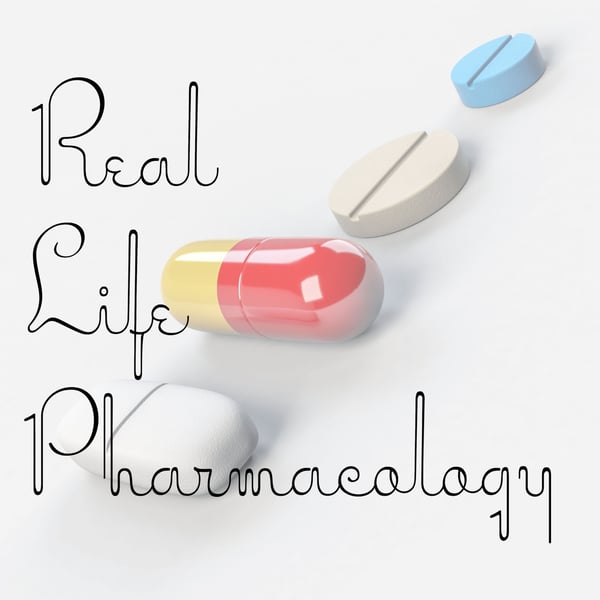Scopolamine Pharmacology
Real Life Pharmacology - Pharmacology Education for Health Care Professionals
Eric Christianson, PharmD; Pharmacology Expert and Clinical Pharmacist
5 • 716 Ratings
🗓️ 19 November 2020
⏱️ 11 minutes
🧾️ Download transcript
Summary
Scopolamine patches can be used in the management of motion sickness and surgery/anesthesia induced nausea and vomiting.
Transdermal scopolamine has a slow onset of action so we need to be deliberate about the timing of placement (usually 4-6 hours prior to anticipated time of symptoms).
Transdermal scopolamine is highly anticholinergic and can cause dry eyes, dry mouth, urinary retention, and confusion.
Transcript
Click on a timestamp to play from that location
| 0:00.0 | Hey all, welcome back to the Real Life Pharmacology podcast. I'm your host, pharmacist Eric Christensen, |
| 0:06.1 | and I thank you so much for listening today. If you are looking for a free 31-page PDF, |
| 0:12.3 | definitely go check out real-life pharmacology.com. It's a top 200 study guide where I lay out the most important and relevant clinical pearls |
| 0:24.3 | as well as those things that come up on pharmacology exams on a regular basis there. |
| 0:31.3 | So definitely go take advantage of that free resource simply for subscribing. |
| 0:44.0 | We'll send you updates as to when we've got new podcasts available and new content as well. |
| 0:52.9 | All right, so the drug of the day today is scopolamine and specifically transdermal scopolamine. |
| 0:55.2 | Now this is classified as an anticholonergic medication, and its primary use is the |
| 1:03.0 | prevention of nausean vomiting, and that could be due to a couple of reasons. |
| 1:08.9 | Most common reason I've seen this medication used in clinical practice |
| 1:13.6 | is for motion sickness, but it can also be used for nausea and vomiting associated with |
| 1:20.8 | anesthesia or general surgery. Now, how does this medication work? |
| 1:29.2 | Again, being an anticholinergic medication, it's going to block muscarinic receptors, possibly also has some an antihistamine-type activity, and it's going to block the action of acetylene, which can ultimately cause some drying up of secretions, |
| 1:52.0 | slow down the gut, and potentially provide some relief for nausea and vomiting, |
| 1:58.5 | which is what we're going to primarily use this medication for. |
| 2:05.1 | Adverse effect profile. So let's talk about this a little bit, because this gives me the |
| 2:11.3 | perfect example of explaining the prescribing cascade. |
| 2:18.8 | So adverse effects, knowing that it's an anti-colonergic medication, |
| 2:24.8 | what you're going to see is dry mouth, dry eyes, potentially constipation, |
| 2:30.0 | and urinary retention. |
| 2:32.9 | In addition, there might be some sedation, confusion, fall risk. |
| 2:38.8 | That's more so probably in our geriatric population. So let's talk about that prescribing cascade. |
... |
Please login to see the full transcript.
Disclaimer: The podcast and artwork embedded on this page are from Eric Christianson, PharmD; Pharmacology Expert and Clinical Pharmacist, and are the property of its owner and not affiliated with or endorsed by Tapesearch.
Generated transcripts are the property of Eric Christianson, PharmD; Pharmacology Expert and Clinical Pharmacist and are distributed freely under the Fair Use doctrine. Transcripts generated by Tapesearch are not guaranteed to be accurate.
Copyright © Tapesearch 2025.

